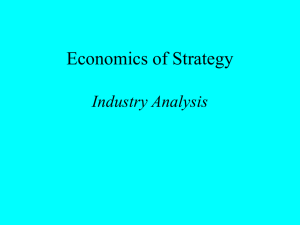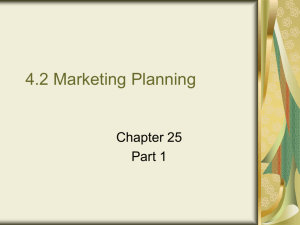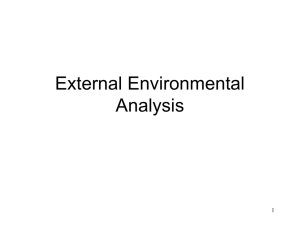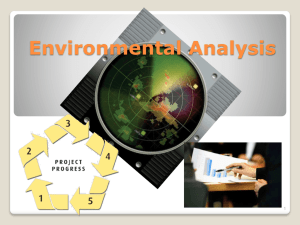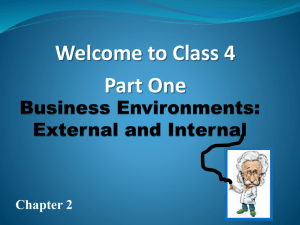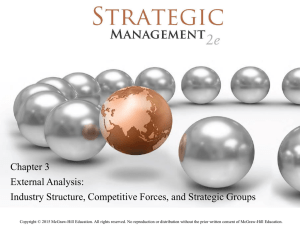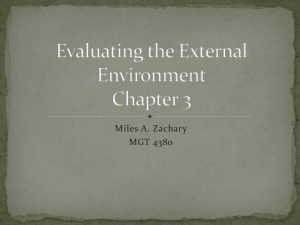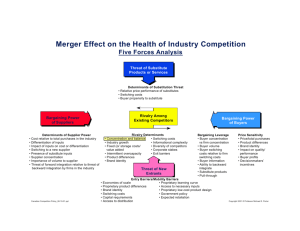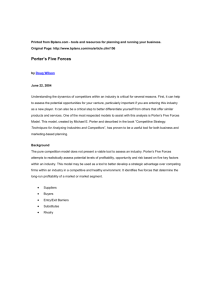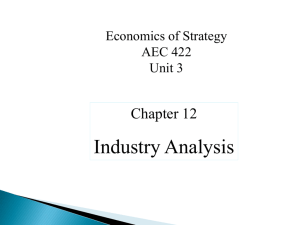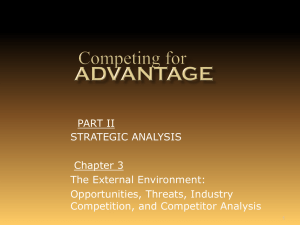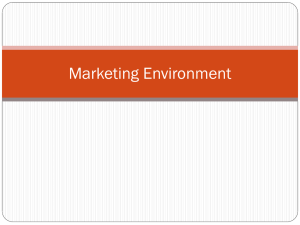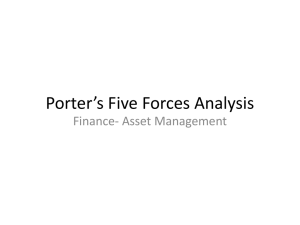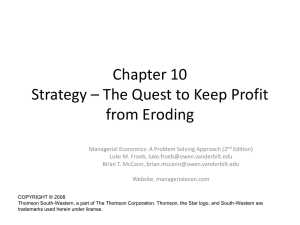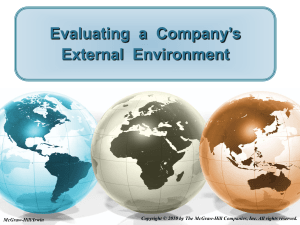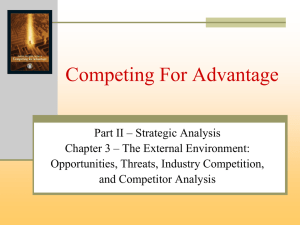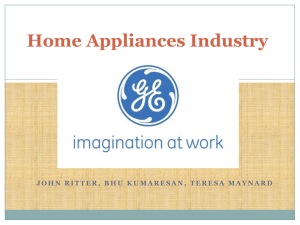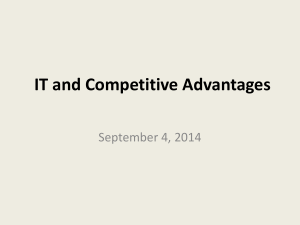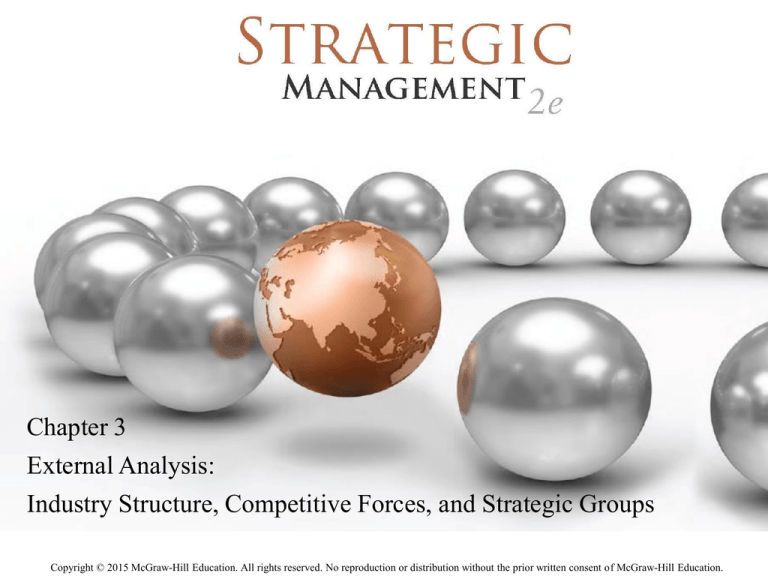
Chapter 3
External Analysis:
Industry Structure, Competitive Forces, and Strategic Groups
Copyright © 2015 McGraw-Hill Education. All rights reserved. No reproduction or distribution without the prior written consent of McGraw-Hill Education.
3-2
Chapter Outline
3.1 The PESTEL Framework
3.2 Industry Structure and Firm Strategy: The Five Forces
Model
3.3 Changes over Time: Industry Dynamics
3.4 Explaining Performance Differences within the Same
Industry: Strategic Groups
3.5 Implications for the Strategist
3-3
ChapterCase 3
Courtesy of Tesla Motors
Tesla Motors and the U.S. Automotive Industry
With high entry barriers, the BIG THREE – GM, Ford,
and Chrysler – dominated the U.S. car market until the
1980s.
There have been no new recent entrants due to the
HIGH industry entry barriers.
Tesla Motors’ Model S received outstanding market
reception, and was awarded the 2013 MotorTrend Car
of the Year.
3-4
EXTERNAL ANALYSIS
MACRO
• PESTEL Framework
INDUSTRY ANALYSIS
• Five Forces Model
MICRO
COMPETITOR ANALYSIS
• Strategic Group Mapping
3-5
3.1 The PESTEL Framework
KEY CONCEPTS
Managers mitigate threats and exploit opportunities
by analyzing the external environmental forces.
Factors are interdependent.
Framework to scan, monitor, and evaluate important
external factors/trends impacting a firm in its quest
for competitive advantage.
3-6
Exhibit 3.1 The Firm Embedded in
Its External Environment
3-7
Strategy Highlight 3.1
How the Eurozone Crisis Is Hurting Companies
The EU (European Union) began its formation in the
early 1950s.
Today – The euro is the common currency used by 17
of the 27 EU member states.
2009 – Several European countries took on too much
debt and were unable to repay their credit obligations.
Strict austerity programs were enacted.
Banks tightened credit hampering firms worldwide.
3-8
3.2 Industry Structure and Firm
Strategy: The Five Forces Model
Industry
• A group of (incumbent) firms that face the same set of
suppliers and buyers
Industry Analysis
• Identifies the industry's profit potential
• Derive implications for a firm’s strategic position within an
industry
Strategic Position
• A firm’s ability to create value (V) for customers while
containing costs (C)
Competitive Advantage = a large value gap (V - C)
3-9
Strategy Highlight 3.2
The Five Forces in the Airline Services Industry
Low Entry Barriers
Powerful Suppliers
Powerful Buyers
Strong Substitute Threat
Intense Rivalry
RESULTS – Low overall industry profit potential, thus
an “unattractive” industry for investment.
3-10
INDUSTRY FORCES IMPACT FIRM PROFITABILITY
ATTRACTIVE INDUSTRY
Sustainable Competitive Advantage Easier
• High profit potential
• The weaker the five forces
UNATTRACTIVE INDUSTRY
Sustainable Competitive Advantage Harder
• Low profit potential
• The stronger the five forces
3-11
ANALYZING INDUSTRY STRUCTURE USING FIVE –
FORCES
Complementors
Number of complements
Relative value added
Barriers to complement entry
Engagement of complements
Buyer perception of
complements
Complement exclusivity
Supplier Power
• Supplier concentration
• Importance of volume to supplier
• Differentiation of inputs
• Impact of inputs on cost or
differentiation
• Switching costs of firms in the industry
• Presence of substitute inputs
• Threat of forward integration
• Cost relative to total purchases in
industry
Threat of New Entrants (and Entry
Barriers)
• Absolute cost advantages
• Proprietary learning curve
• Access to inputs
• Government policy
• Economies of scale
• Capital requirements
• Brand identity
• Switching costs
• Access to distribution
• Expected retaliation
• Proprietary products
Degree of Rivalry
• Exit barriers
• Industry concentration
• Fixed costs/value
added
• Industry growth
• Intermittent
overcapacity
• Product differences
• Switching costs
• Brand identity
• Diversity of rivals
• Corporate stakes
Threat of Substitutes
• Switching costs
• Buyer inclination to substitute
• Price-performance tradeoff of
substitutes
• Varity of substitutes
• Necessity of product or service
Industry value chain
– from raw materials
and other inputs, to
channel to end
consumer
Buyer Power (Channel and End
consumer)
• Bargaining leverage
• Buyer volume
• Buyer information
• Brand identity
• Price sensitivity
• Threat of backward integration
• Product differentiation
• Buyer concentration vs. industry
• Substitutes available
• Buyer’s incentives
12
The Threat of Entry
Incumbent firms can benefit from several important
sources of entry barriers:
•
•
•
•
•
•
•
Economies of scale
Network effects
Customer switching costs
Capital requirements
Advantages independent of size
Government policy
Credible threat of retaliation
3-13
Strength & Degree of Competitive
Rivalry
Exit barriers in the industry
Quantity and variability of strength in competitive
dynamics
Stage if the industry life-cycle
Industry fragmentation vs. consolidation
Perceptions of customer switching costs
3-14
The Power of Suppliers
POWERFUL SUPPLIERS
Can demand higher prices for their inputs.
Capture part (sometimes a large part) of the economic
value created.
-
Signs of Strong Suppliers
Suppliers industry is concentrated.
They don’t depend heavily on the incumbent’s industry.
Incumbent firms face high switching costs.
Suppliers’ products are differentiated.
Limited substitutes
Suppliers have credible forward integration threats.
3-15
The Power of Buyers
The bargaining power of buyers impacts industry profit potential.
POWERFUL BUYERS
Can demand a lower price or higher product quality
Reduce industry profit potential:
•
•
•
•
Through price discounts (limited revenue)
Through increased quality / better service (higher costs)
As they capture part of the economic value created
Credible threat of backwards integration
3-16
The Threat of Substitutes
This threat derives from products/services fulfilling the
needs of current customers from outside the industry.
POWERFUL SUBSTITUTES: THE POWER OF
SUBSTITUTES is HIGH when:
• Price-performance: Has an attractive trade-off
• The buyer’s switching cost is low
• Breadth/availability of substitute options
Substitutes limit the price that industry competitors can
charge for their products/services.
3-17
Exhibit 3.3
Industry Competitive Structures Along
The Continuum From Fragmented To Consolidated
3-18
Adding a Sixth Force:
The Strategic Role of Complements
COMPLEMENT
• A product, service, or competency that adds value when
used in tandem with the original product offering
Complementor – A firm that provides a good/service
that leads customers to value your firm’s offering
more when the two are combined
Co-opetition – Cooperation by competitors to
achieve a strategic objective
3-19
3.3 Changes over Time:
Industry Dynamics
The static five forces model cannot determine the
speed of change for an industry.
As consolidated industries tend to be more profitable
than fragmented ones, firms tend to change their
industry structures toward being more consolidated
through (horizontal) mergers and acquisitions.
Industry Profitability
Consolidation
3-20
Exhibit 3.5
Strategic Groups and the Mobility
Barriers in the U.S. Domestic Airline Industry
3-21
3.4 Explaining Performance Differences
Within the Same Industry: Strategic Groups
Firms in the same strategic group follow a similar
strategy.
Strategic group differences identify business-level
strategies.
Direct competitors – same strategic group firms.
Intra-group rivalry exceeds inter-group rivalry:
• Rivalry among firms within a strategic group is more intense
than the rivalry between strategic groups.
3-22
3.5 Implications for the Strategist
PESTEL analysis guiding consideration: How the
external factors identified affect the firm’s industry
environment
Porter’s five forces model identifies industry profit
potential and firm positioning for gaining and
sustaining competitive advantage.
Strategic group map helps to find performance
differences within the focal industry.
3-23
ChapterCase 3
Courtesy of Tesla Motors
Consider This…
• Recent dynamics in the automotive industry have lowered the
profit potential, reducing its attractiveness.
• Tesla Motors has demonstrated how new technology can be
used to circumvent entry barriers.
• However, incumbent firms are also introducing hybrid or allelectric cars, further increasing rivalry in the industry.
3-24
3-25

